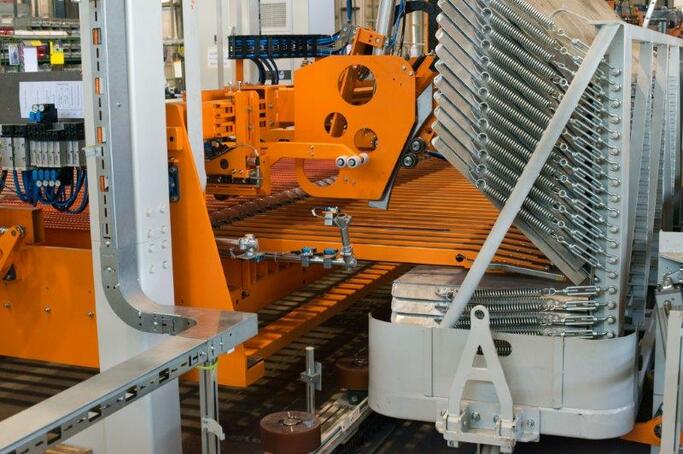
16.August 2017
Tread Booking Systems have been established in the last 40 years
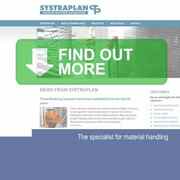 Tread deformation is a good example. Improper handling can cause transversal and longitudinal deformations. Especially dimensions and weight of truck treads make it hard for operators to handle the treads in a proper and appropriate manner.
Tread deformation is a good example. Improper handling can cause transversal and longitudinal deformations. Especially dimensions and weight of truck treads make it hard for operators to handle the treads in a proper and appropriate manner. Automatic tread booking avoids the disadvantages associated with the manual tread handling.
Continuous Development
Automatic booker loading devices made by SYSTRAPLAN are well-known and used in the tyre industry for quality assurance of treads and tyres as well as for rationalisation.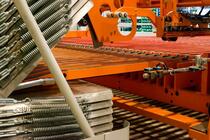 SYSTRAPLAN, specialist for material handling equipment when it comes to flat materials, started producing auto booking and handling systems for the tyre industry in 1977.
SYSTRAPLAN, specialist for material handling equipment when it comes to flat materials, started producing auto booking and handling systems for the tyre industry in 1977. This machine type has been continuously developed based on a large number of machines built and vast experience gained in the last 40 years.
Reduced Machine Downtime and Improved Quality
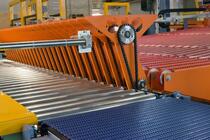 Many details have been improved to ensure a better and faster maintenance or possibly repair in order to reduce machine downtimes and to raise the reliability of the auto booking systems.
Many details have been improved to ensure a better and faster maintenance or possibly repair in order to reduce machine downtimes and to raise the reliability of the auto booking systems.Tyre quality depends on correct transport and storing of the treads. It does not matter what booker type is used or whether the treads need to be flipped or not, what counts is the accurate and uniform depositing of the green treads on the trays of the leaf trucks to guarantee a constant high quality.
Loading through Belt Tray Mechanism
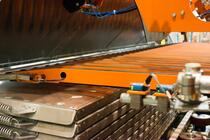 The tread loading is achieved by the heart of the loading system: The belt tray mechanism. The treads come from the transferring conveyor and are transferred to an accumulation belt conveyor, where they are collected in a batch with precise lateral spacing in between.
The tread loading is achieved by the heart of the loading system: The belt tray mechanism. The treads come from the transferring conveyor and are transferred to an accumulation belt conveyor, where they are collected in a batch with precise lateral spacing in between. After the buffering, a complete batch is transferred onto the belt tray. The belt tray moves with the batch into the open leaf truck.
Immediately after reaching the end position, the belt tray begins to retract while its belts are running forward at exactly the same speed of the retracting belt tray. In this way the tread batch is kept stationary in relation to the leaf and thus precisely positioned on the leaf.
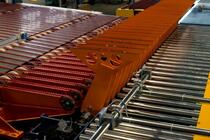 The advantage of the belt tray lies in the fact that the treads always keep on lying on the belts with a tight spacing and due to their own weight; and the surface can be finely structured or freshly cemented as it is not touched.
The advantage of the belt tray lies in the fact that the treads always keep on lying on the belts with a tight spacing and due to their own weight; and the surface can be finely structured or freshly cemented as it is not touched.All tread loading systems provide the following advantages:
- Improved product quality
- Continuous production - increased output
- Reduction in manpower
Major Components of a Loading System
Automatic Tread Booking Systems that handle up to 30 treads per minute mainly comprise of following major components:- Feeding roller conveyor with variable speeds
- Manual booking station for rejected treads
- Vacuum flipping or lateral transfer station
- Cross transfer conveyor system for forming and buffering batches
- Lifting platform with belt tray mechanism for loading the trays of the leaf trucks
- Automatic leaf fold-down in combination with down holding elements
- Automatic leaf truck conveyor system for a loading process without an interruption
- Electrical control system
 Several additional solutions that are connected with tread booking, such as manual booking and work-off stations, have become well established. Treads with false length or weight are automatically eliminated.
Several additional solutions that are connected with tread booking, such as manual booking and work-off stations, have become well established. Treads with false length or weight are automatically eliminated.Fully automatic solutions for the handling of scrap are added to the range.
